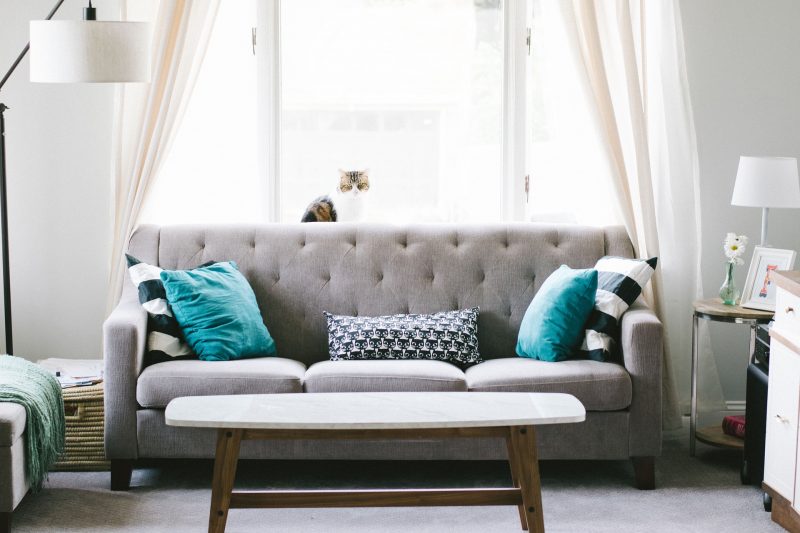I think we can all agree that curtains definitely add a little something to the table. But it needs to blend well with your other living room aesthetics to make a statement. Don’t worry, as we have detailed steps, tips, and tricks that will teach you how to choose curtains for living rooms.

When choosing curtains, the color, type of fabric, patterns, length, and accessories should complement or fit with focal points of the living room like your sofas and other large furniture. Otherwise, it’s just another piece of decorative furniture that failed to fulfill its aesthetic duty.
What are curtains?
It’s easy to look at shades, curtains, blinds, and drapes and label them as curtains. After all, they do have just a single function. Well, not exactly. Blinds, shades, curtains, and drapes all serve different purposes.
While there is a significant difference between curtains and blinds, most people find it difficult to determine whether their living room needs a curtain or a drape. Some sadly don’t even know the difference between the two. Do you?
Drapes are usually made from thicker fabric to block out sunlight. Curtains, on the other hand, are from lighter materials that let sufficient sunlight while maintaining privacy. Now that we’ve established what a curtain is, we can now explore our options.
Choosing your curtains
Like we’ve mentioned earlier, there are at least five things that you need to consider in choosing the right curtain for your living room. Since there are thousands of designs to choose from, we’ll help you narrow down your options with these particular steps.
1. Decide on the fabric
Manufacturers usually make a ton of different colors from the same fabric. The initial step to narrow down our options is by deciding on the type of fabric that your living room needs. Material plays a crucial role in the functional and aesthetic parts of your curtain.
You can choose from sheer lace to thin cotton, medium-heavy brocades, and rich velvet. Each of these materials permits a specific amount of sunlight to penetrate and light up the room. Heavier fabrics are more restricting, while lighter materials give you a naturally lit space.
The fabric can also impact the overall mood of your living room. If you have a relatively small space, try to go for lighter materials to make the room appear bigger than it really is. Rich velvet curtains create a sophisticated atmosphere but suit living rooms that are larger in size.
2. Choose the color scheme
If you want a living room that looks like it came right out of a magazine page, then color should be your best friend. Great interior design ideas always follow a specific color scheme. It gives the room a sense of character and pulls the design together.
For this part, you might want to go back to your color wheel and refresh on primary accent and complementary color combinations. Ideally, the color you choose should either accentuate, contrast, or complement your walls and existing furniture, huge ones.
Opt for a light or neutral color for curtains that blend in the background. These will set with the walls and serve as a relaxing backdrop. You can also turn your curtains into a focal point by selecting a hue that contrasts the wall and furniture. Make it stand out with bold and vibrant colors.
3. Choose the design
Solid curtains are great, especially if all your other furniture has bold prints or geometric patterns. It also encourages a more subtle appeal and blends well with your walls and background. Balance your printed or patterned wall and furniture with solid colored curtains.
Bold patterns and textured curtains will create a lively atmosphere in your living room. Spice it up by hanging a printed and brightly colored curtain to match your solid color furniture. There are also lighter patterns for a more delicate approach.
4. Measure the length
Make your windows seem larger, wider, or complement it as it is when you play around with different curtain lengths. For instance, smaller living rooms can appear larger with curtains hung just a few inches below the ceiling.
Length is also an important aspect when choosing the curtains. Decide on whether you want it floating, puddling, or simply touching your living room floor. Knowing how a particular curtain length affects the design can help you achieve the style you are going for.
Curtains don’t have to be hung directly above the window sill. You can try hanging it just a few inches below the ceiling. This adds height to your windows, making them appear taller and the room larger.
5. Accessories
Some curtains look good as they are, while others might need an accessory or two for a more fashionable statement. Dress up or tone down your curtain based on its material and design. Velvet and other heavy materials can look better than they already are with a few decorative frilled fabrics placed at the top.
In Summary
Choosing the perfect curtain that will complement your living room aesthetics can be pretty jarring. Sometimes it looks good but not exactly as engaging as you’d like it to be. It’s okay to feel overwhelmed with all the available textiles, as long as you know how to narrow down your search. Otherwise, you’d end up in a relatively infinite loop of not getting the perfect curtain.
Hopefully, we’ve given you valuable insight on how to choose curtains for living room designs. Remember that a curtain serves both practical and visual purposes. Always try to get the best of both worlds when it comes to choosing suitable curtains.
